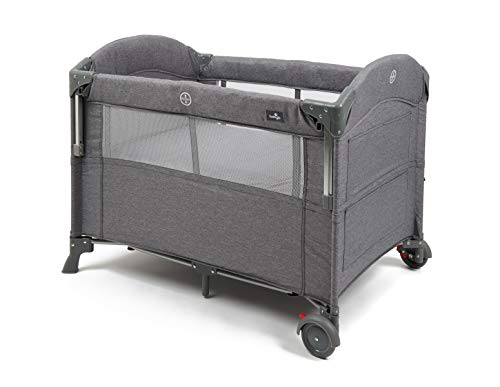The Hidden Secrets Of Bedside Crib For Attachment Parenting
The Benefits of Bedside Cribs for Attachment Parenting
Attachment parenting is a child-rearing viewpoint that stresses the value of forming a strong emotional bond between a moms and dad and child. Among the essential elements of this method is co-sleeping, which promotes close physical proximity in between parents and their infants. Bedside cribs have actually acquired substantial popularity as a useful and safe sleeping option that allows parents to practice attachment parenting efficiently. This post looks into the benefits of bedside cribs, their features, and essential considerations for parents.
What is a Bedside Crib?
A bedside crib, likewise known as a sidecar crib, is a type of infant sleeping arrangement that attaches safely to the side of a parent's bed. This design allows the baby to oversleep their own separate space while keeping easy access for feeding, soothing, and tracking. just click the up coming post come in different designs, from simple mesh designs to wood cribs that match the decor of the parents' bed room.
Key Features of Bedside Cribs
When thinking about a bedside crib, it's vital to analyze its features to guarantee it matches the requirements of both parent and baby. Here are some crucial qualities to watch out for:
Feature
Description
Adjustable Height
Numerous bedside cribs have adjustable height settings to line up with the moms and dad's mattress.
Side Panel Access
A side panel that can be decreased enables for easy access to the baby throughout the night.
Tough Construction
High-quality products, such as strong wood or durable metal frames, supply stability and safety.
Safety Features
Try to find cribs with safety accreditations and functions such as secure locking mechanisms.
Breathable Materials
Bedside cribs typically make use of breathable fabrics to promote air circulation, minimizing the threat of suffocation.
Benefits of Bedside Cribs for Attachment Parenting
1. Promotes Bonding
Bedside cribs help with a nurturing environment where infants can sense their parents' presence, which cultivates psychological security and attachment. The close distance assists parents react more promptly to their baby's requirements throughout sleep, promoting a sense of security and trust.
2. Alleviate of Feeding
For breastfeeding mothers, bedside cribs offer unparalleled benefit for nighttime feeding. Mothers can quickly reach their baby without rising, making late-night feedings less disruptive for both parent and child.
3. Lowers Risks Associated with Co-Sleeping
While co-sleeping can promote attachment, it likewise carries risks such as suffocation and falling. Bedside cribs provide a compromise, offering a safe sleeping space for the baby while still allowing parents to sleep nearby.
4. Better Sleep for Parents
Since parents can participate in to their baby's needs without completely waking or leaving the bed, they can preserve much better sleep quality. This is especially crucial throughout the early months when sleep deprivation can take a toll on adult health.
5. Increased Convenience
With a bedside crib, parents can quickly monitor their baby's motions and listen for any nighttime fussing, enabling quicker interventions when essential. This benefit is especially useful for parents requiring to handle their time efficiently.
Picking the Right Bedside Crib
When selecting a bedside crib that lines up with the concepts of attachment parenting, parents need to consider numerous elements:
- Safety Standards: Always select a crib that meets security guidelines and standards to guarantee the infant's wellness.
- Size Compatibility: Ensure the crib fits safely next to the moms and dad's bed and can be adjusted for height.
- Ease of Access: Look for features that permit easy side access, particularly useful for breastfeeding.
- Mobility: If travel belongs to domesticity, consider a crib that is lightweight and quickly transportable.
- Budget: Bedside cribs come in a variety of rate varieties. There are many cost effective options that do not compromise on safety or quality.
Often Asked Questions (FAQs)
Q1: Are bedside cribs safe for newborns?A1: Yes, bedside cribs are designed with safety features to make sure a safe and secure sleeping environment for newborns. Always follow the maker's guidelines and safety standards. Q2: Will my baby outgrow a bedside
crib quickly?A2: It depends upon the design. Most bedside cribs can accommodate
infants as much as 6-12 months, but it's crucial to check the weight and height limits specified by the manufacturer. Q3: Can I use a bedside crib if I have a smaller bed?A3: Yes, lots of bedside cribs are adjustable and
can be aligned with numerous bed sizes. Always make sure the attachment is safe and secure. Q4: How does a bedside crib vary from co-sleeping? A4: Co-sleeping involves sharing the same sleep surface area
, while bedside cribs provide a separate sleeping
space for the baby, maintaining safety and promoting attachment. Q5: Can I use a bedside crib if I'm not breastfeeding?A5: Absolutely! Bedside cribs are helpful for all parents and caretakers, making it easier
to comfort and address a baby, regardless of feeding techniques. Bedside cribs represent an indispensable tool for parents who embrace attachment parenting. They not just permit physical nearness however also boost safety and benefit during the newborn phase. Parents need to thoroughly select a bedside crib that abides by safety requirements and fits their way of life, guaranteeing a supporting environment for both baby and parent. By promoting bonding, ease of feeding, and much better sleep for parents, bedside cribs play a substantial function in cultivating the principles of attachment parenting— a rewarding journey that nurtures a more powerful, caring connection in between parents and their kids. 